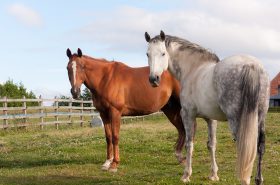Have you ever gone out to feed or catch your horse only to find that their eye is weepy and
swollen? It can be worrisome, for sure.
Equine eye issues should always be taken seriously. Even minor problems can turn into
something more serious; if you’re ever in doubt, call your vet for a diagnosis and treatment.
With that said, I thought I’d share some information on the most common eye issues seen in
horses and how to recognize them.
Corneal Ulcers
Corneal ulcers are caused from a break or tear in the surface of the outer layer of the eye. They
often develop as a result of trauma, such as plant material scratching the eye. Symptoms
include redness, tearing, squinting, cloudiness and/or irregularities in the cornea. More serious
corneal ulcers can result in infection of the eye, which could lead to further complications.
Blocked Tear Ducts
Blocked tear ducts are not especially painful for the horse, but result in almost continuous
watery discharge, usually from one eye. They can occur for several reasons, including
accumulation of debris or mucous, or from a structural problem, such as a narrow or damaged
tear duct. A blocked tear duct can sometimes be dealt with by cleaning the eye twice a day with
a sterile solution and using a fly mask. However, if it doesn’t resolve, you may need to have your
vet ‘flush’ the tear duct.
Conjunctivitis
Conjunctivitis involves inflammation of the inner lining of the upper and lower eyelids. This is
one eye issue that can be contagious, so you may see all your horses developing this problem
around the same time. Conjunctivitis can also be caused by a bacterial infection (often
secondary to another illness), or possibly flies or environmental irritants. Itching and irritation are
usually the first signs of conjunctivitis, often followed by clear or yellowish discharge, swollen
eyelids, a closed eye or squinting, sensitivity to light and dust, rubbing the eye, and possibly
head-shaking.
Uveitis (Moon Blindness)
Uveitis involves inflammation of the uveal tissue inside the eye. The symptoms can be very
similar to those of corneal ulcers, but may also include a constricted pupil and iris color
changes. Uveitis can have many causes, and Equine Recurrent Uveitis (ERU) is diagnosed
when this condition recurs on a frequent basis. ERU often leads to irreversible damage to the
eye, and eventually, blindness. Early detection is important to slow inflammation and hopefully
preserve the horse’s eyesight.



